check engine Oldsmobile Achieva 1995 s User Guide
[x] Cancel search | Manufacturer: OLDSMOBILE, Model Year: 1995, Model line: Achieva, Model: Oldsmobile Achieva 1995Pages: 340, PDF Size: 16.99 MB
Page 164 of 340
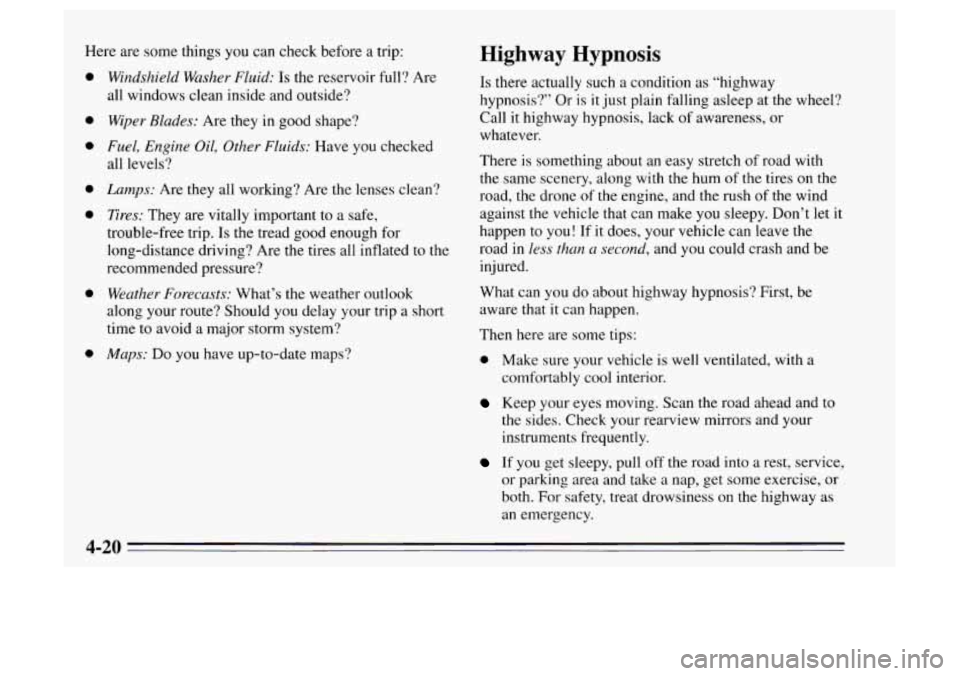
Here are some things you can check before a trip:
0
0
0
0
0
0
0
Windshield Washer Fluid: Is the reservoir full? Are
all windows clean inside and outside?
Wiper Blades: Are they in good shape?
Fuel, Engine Oil, Other Fluids: Have you checked
all levels?
Lamps: Are they all working? Are the lenses clean?
Tires: They are vitally important to a safe,
trouble-free trip. Is the tread good enough for
long-distance driving? Are the tires all inflated
to the
recommended pressure?
Weather Forecasts: What’s the weather outlook
along your route? Should you delay your trip a short
time to avoid
a major storm system?
Maps: Do you have up-to-date maps?
Highway Hypnosis
Is there actually such a condition as “highway
hypnosis?” Or
is it just plain falling asleep at the wheel?
Call
it highway hypnosis, lack of awareness, or
whatever.
There is something about an easy stretch
of road with
the same scenery, along with the hum of the tires on the
road, the drone
of the engine, and the rush of the wind
against the vehicle that can make you sleepy. Don’t let it
happen to you! If it does, your vehicle can leave the
road in
less than a second, and you could crash and be
injured.
What can you
do about highway hypnosis? First, be
aware that it can happen.
Then here are some tips:
0 Make sure your vehicle is well ventilated, with a
comfortably cool interior.
Keep your eyes moving. Scan the road ahead and to
the sides. Check your rearview mirrors and your
instruments frequently.
If you get sleepy, pull off the road into a rest, service,
or parking area and take a nap, get some exercise,
or
both. For safety, treat drowsiness on the highway as
an emergency.
4-20
Page 165 of 340
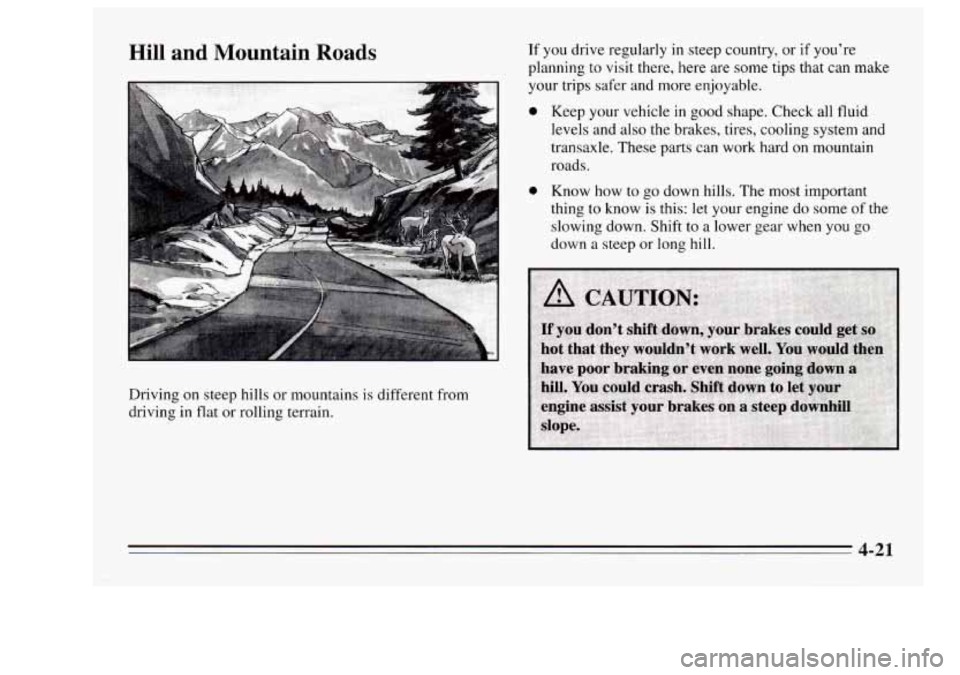
Hill and Mountain Roads
Driving on steep hills or mounta
driving in flat
or rolling terrain. .ins
is different
from
If you drive regularly in steep country, or if you’re
planning
to visit there, here are some tips that can make
your trips safer and more enjoyable.
0
0
Keep your vehicle in good shape. Check all fluid
levels and also the brakes, tires, cooling system and
transaxle. These parts can work hard on mountain
roads.
Know how to go down hills. The most important
thing to know is this:
let your engine do some of the
slowing down. Shift
to a lower gear when you go
down a steep or long hill.
4-21
Page 182 of 340
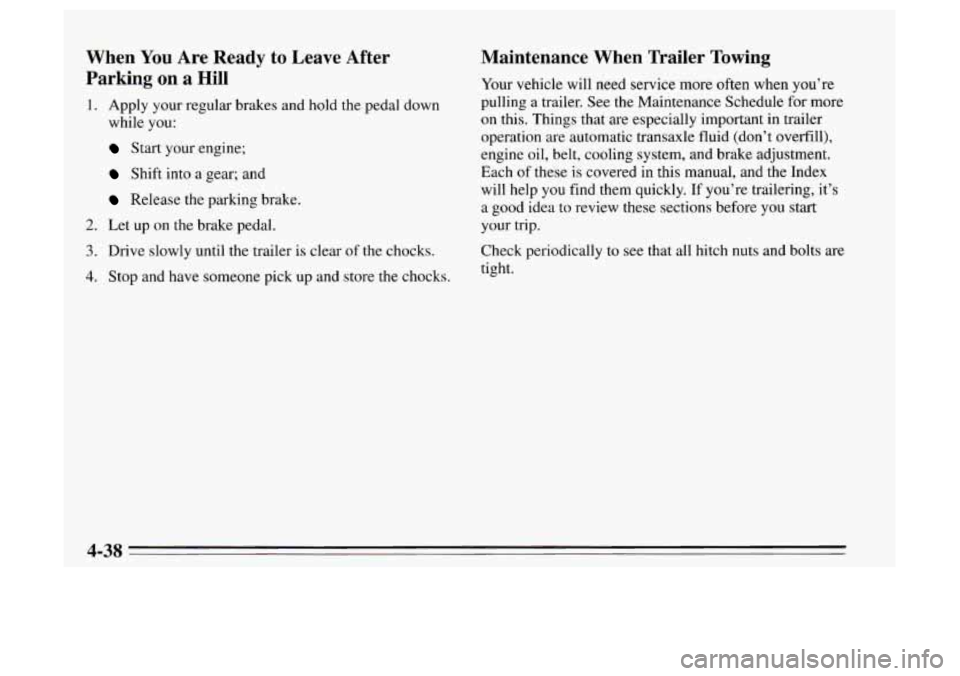
When You Are Ready to Leave After
Parking on a
Hill
1. Apply your regular brakes and hold the pedal down
while
you:
Start your engine;
Shift into a gear; and
Release the parking brake.
2. Let up on the brake pedal.
3. Drive slowly until the trailer is clear of the chocks.
4. Stop and have someone pick up and store the chocks.
Maintenance When Trailer Towing
Your vehicle will need service more often when you’re
pulling a trailer. See the Maintenance Schedule for more
on this. Things that are especially important in trailer
operation are automatic transaxle fluid (don’t overfill),
engine
oil, belt, cooling system, and brake adjustment.
Each
of these is covered in this manual, and the Index
will help
you find them quickly. If you’re trailering, it’s
a
good idea to review these sections before you start
your trip.
Check periodically to see that all hitch nuts and bolts are
tight.
4-38
-
Page 186 of 340
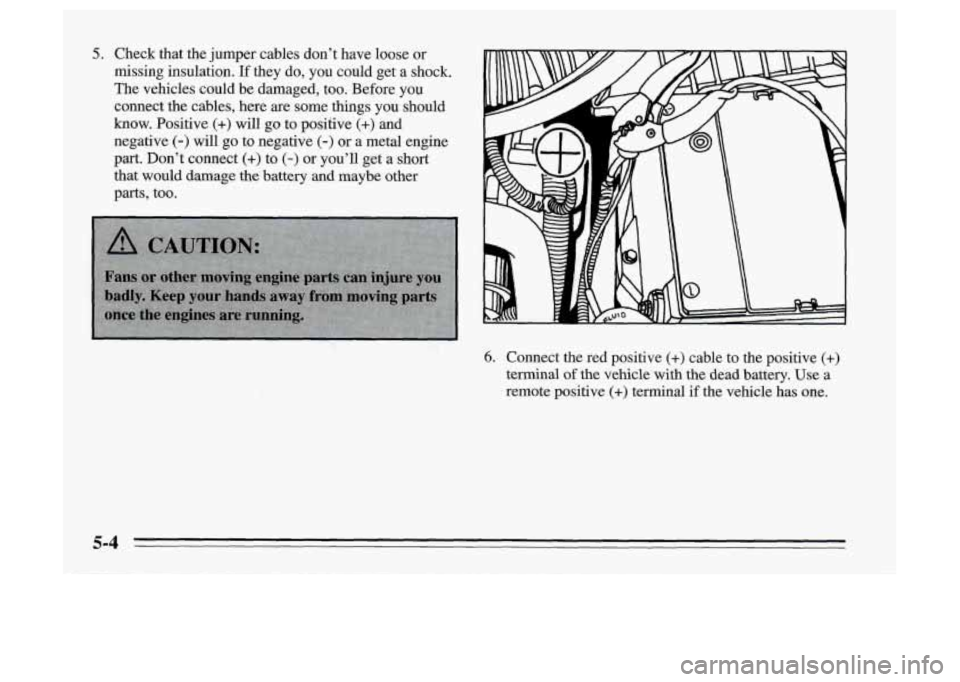
5. Check that the jumper cables don’t have loose or
missing insulation.
If they do, you could get a shock.
The vehicles could be damaged, too. Before you
connect
the cables, here are some things you should
know. Positive
(+) will go to positive (+) and
negative (-) will go to negative (-) or a metal engine
part. Don’t connect
(+) to (-) or you’ll get a short
that would damage the battery and maybe other
parts, too.
6. Connect the red positive (+) cable to the positive (+)
terminal of the vehicle with the dead battery. Use a
remote positive
(+) terminal if the vehicle has one.
5-4
Page 197 of 340
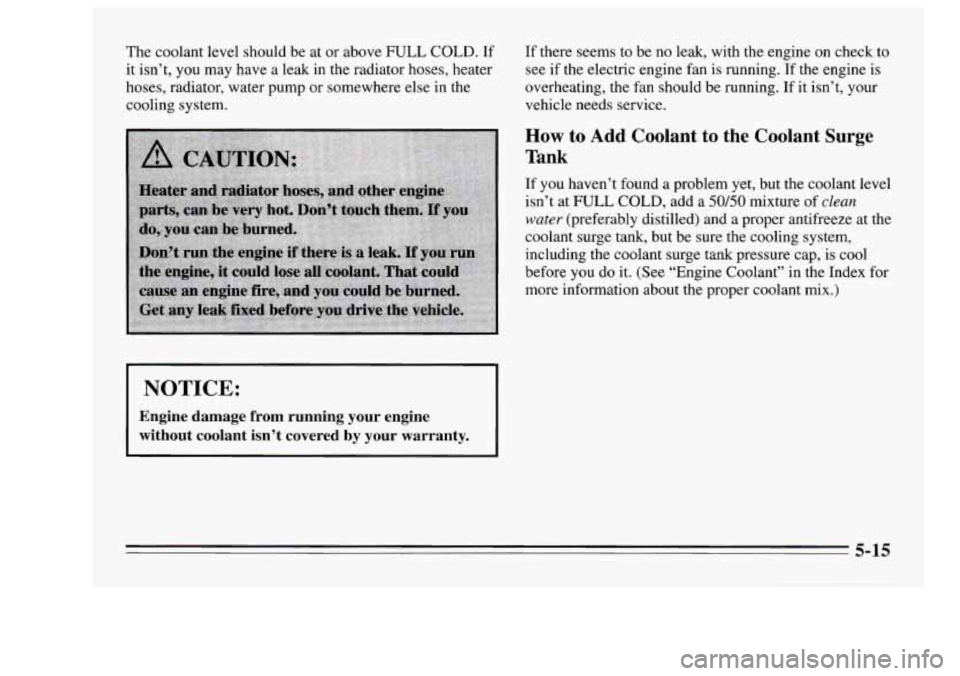
The coolant level should be at or above FULL COLD. If
it isn’t, you may have a leak in the radiator
hoses, heater
hoses, radiator, water pump or somewhere else in the
cooling system.
r
NOTICE:
Engine damage from running your engine
without coolant isn’t covered by your warranty.
If there seems to be no leak, with the engine on check to
see if the electric engine fan is running. If the engine is
overheating, the fan should be running. If it isn’t, your
vehicle needs service.
How to Add Coolant to the Coolant Surge
Tank
If you haven’t found a problem yet, but the coolant level
isn’t at
FULL COLD, add a 50/50 mixture of clean
water (preferably distilled) and a proper antifreeze at the
coolant surge tank, but be sure the cooling system,
including the coolant surge tank pressure cap,
is cool
before you do it.
(See “Engine Coolant” in the Index for
more information about the proper coolant mix.)
5-15
Page 214 of 340
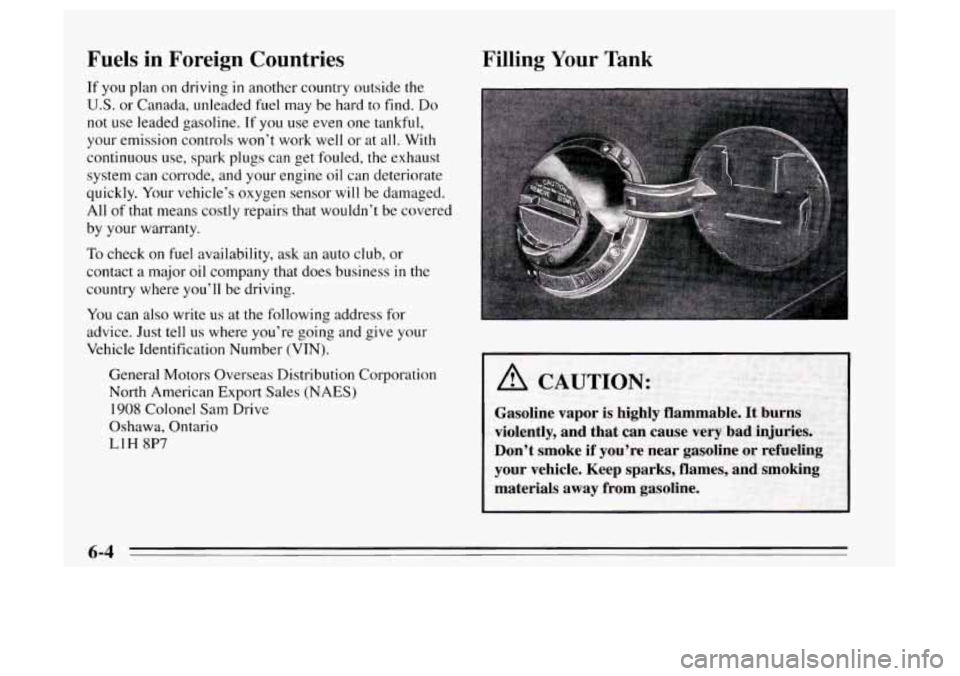
Fuels in Foreign Countries
If you plan on driving in another country outside the
U.S. or Canada, unleaded fuel may be hard to find. Do
not use leaded gasoline. If you use even one tankful,
your emission controls won’t work well or at
all. With
continuous use, spark plugs can get fouled, the exhaust
system can corrode, and your engine
oil can deteriorate
quickly. Your vehicle’s oxygen sensor will be damaged.
All of that means costly repairs that wouldn’t be covered
by your warranty.
To check on fuel availability, ask an auto club, or
contact
a major oil company that does business in the
country where you’ll be driving.
You can
also write us at the following address for
advice. Just tell us where you’re going and give your
Vehicle Identification Number (VIN).
General Motors Overseas Distribution Corporation North American Export Sales
(NAES)
1908 Colonel Sam Drive
Oshawa, Ontario
LIH 8P7
Filling Your Tank
6-4
Page 221 of 340
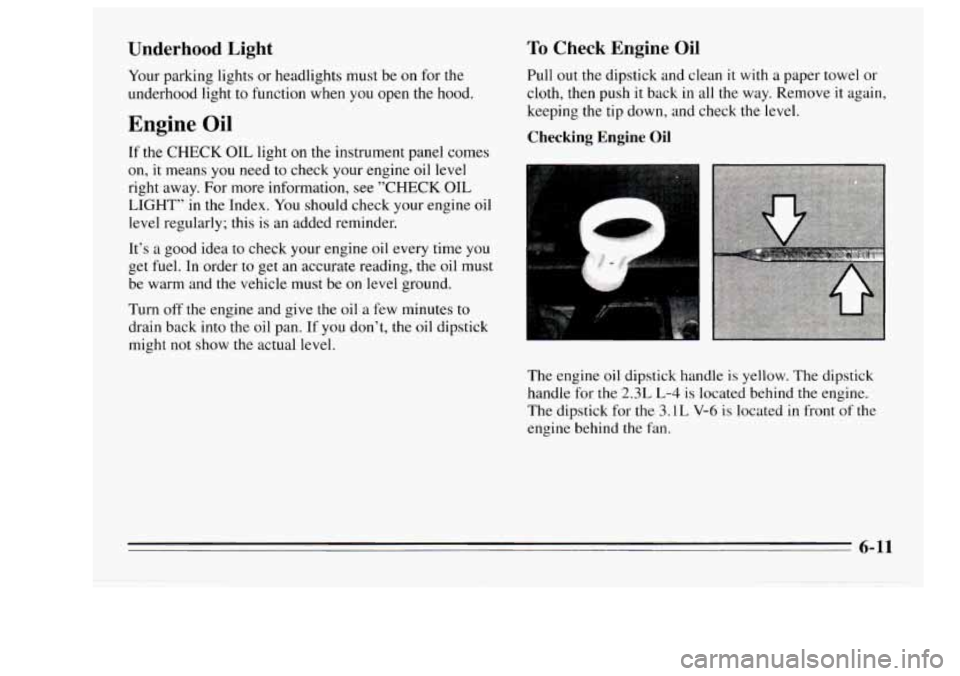
Underhood Light
Your parking lights or headlights must be on for the
underhood light
to function when you open the hood.
Engine Oil
If the CHECK OIL light on the instrument panel comes
on, it means you need to check your engine oil level
right away. For more information, see
”CHECK OIL
LIGHT” in the Index. You should check your engine oil
level regularly; this is an added reminder.
It’s a good idea
to check your engine oil every time you
get fuel.
In order to get an accurate reading, the oil must
be warm and the vehicle must be
on level ground.
Turn
off the engine and give the oil a few minutes to
drain back into the oil pan. If you don’t, the oil dipstick
might not show the actual level.
To Check Engine Oil
Pull out the dipstick and clean it with a paper towel or
cloth, then push it back in all the way. Remove it again,
keeping the tip down, and check the level.
Checking Engine Oil
The engine oil dipstick handle is yellow. The dipstick
handle for the
2.3L L-4 is located behind the engine.
The dipstick for the 3.1L
V-6 is located in front of the
engine behind the fan.
6-11
Page 226 of 340
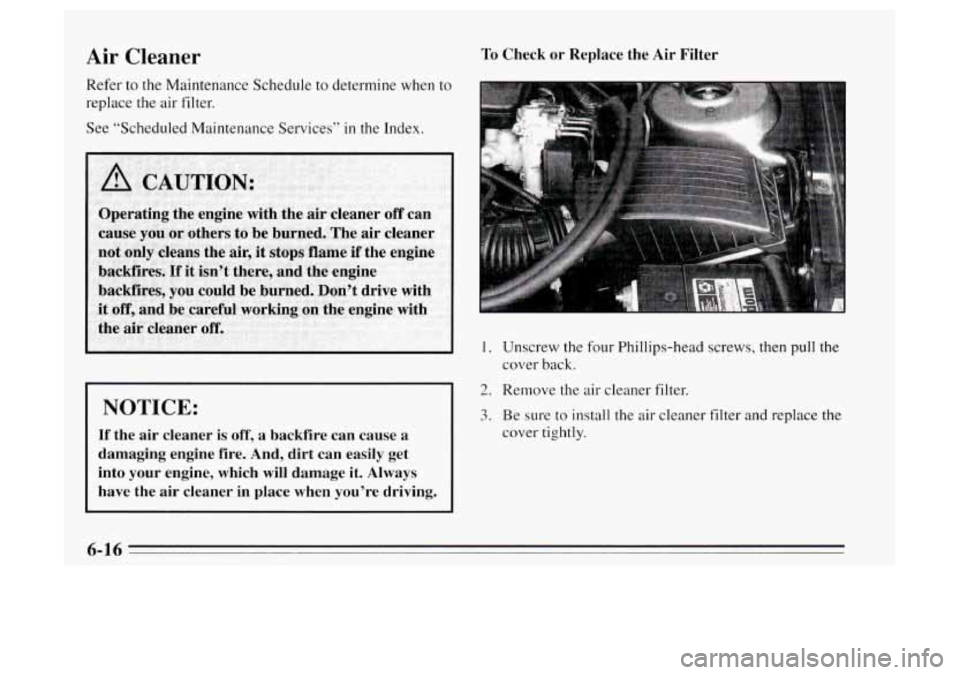
Air Cleaner
Refer to the Maintenance Schedule
replace
the air filter. to determine when to
See “Scheduled Maintenance Services”
in the Index.
I NOTICE:
If the air cleaner is off, a backfire can cause a
damaging engine fire. And, dirt can easily get
into your engine, which
will damage it. Always
have the air cleaner in place when you’re driving.
To Check or Replace the Air Filter
1. Unscrew the four Phillips-head screws, then pull the
cover back.
2. Remove the air cleaner filter.
3. Be sure to install the air cleaner filter and replace the
cover tightly.
6-16
Page 227 of 340
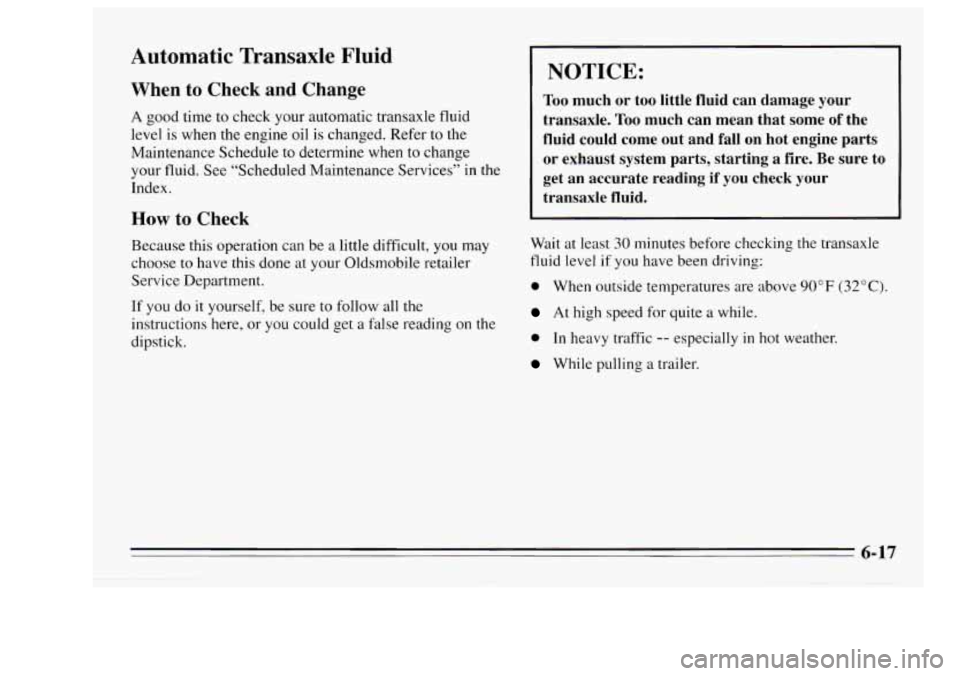
Automatic Transaxle Fluid
When to Check and Change
A good time to check your automatic transaxle fluid
level
is when the engine oil is changed. Refer to the
Maintenance Schedule to determine when to change
your fluid. See “Scheduled Maintenance Services’’ in the
Index.
How to Check
Because this operation can be a little difficult, you may
choose
to have this done at your Oldsmobile retailer
Service Department.
If you do it yourself, be sure to follow all the
instructions here, or you could get a false reading on the
dipstick.
NOTICE:
Too much or too little fluid can damage your
transaxle.
Too much can mean that some of the
fluid could come out and fall on hot engine parts or exhaust system parts, starting a fire. Be sure to get an accurate reading if you check your
transaxle fluid.
Wait at least 30 minutes before checking the transaxle
fluid level if you have been driving:
0 When outside temperatures are above 90 OF (32 O C).
At high speed for quite a while.
0 In heavy traffic -- especially in hot weather.
While pulling a trailer.
6-17
Page 228 of 340
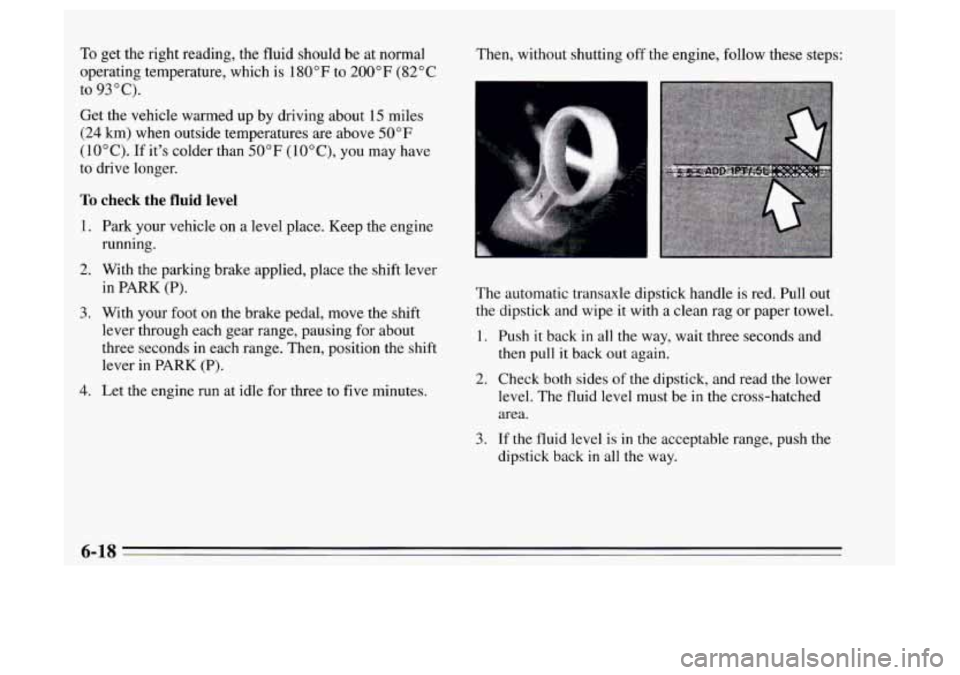
To get the right reading, the fluid should be at normal
operating temperature, which is 180°F to
200°F (82°C
Get the vehicle warmed up by driving about 15 miles
(24 km) when outside temperatures are above 50°F
(10°C). If it's colder than
50°F (1O"C), you may have
to drive longer.
to
93°C).
To check the fluid level
1.
2.
3.
4.
Park
your vehicle on a level place. Keep the engine
running.
With the parking brake applied, place the shift lever
in PARK
(P).
With your foot on the brake pedal, move the shift
lever through each gear range, pausing for about
three seconds in each range. Then, position
the shift
lever in PARK
(P).
Let the engine run at idle for three to five minutes. Then,
without shutting
off the engine, follow these steps:
The automatic transaxle dipstick handle is red. Pull out
the dipstick and wipe it with
a clean rag or paper towel.
1. Push it back in all the way, wait three seconds and
then pull it back out again.
2. Check both sides of the dipstick, and read the lower
level.
The fluid level must be in the cross-hatched
area.
3. If the fluid level is in the acceptable range, push the
dipstick back
in all the way.